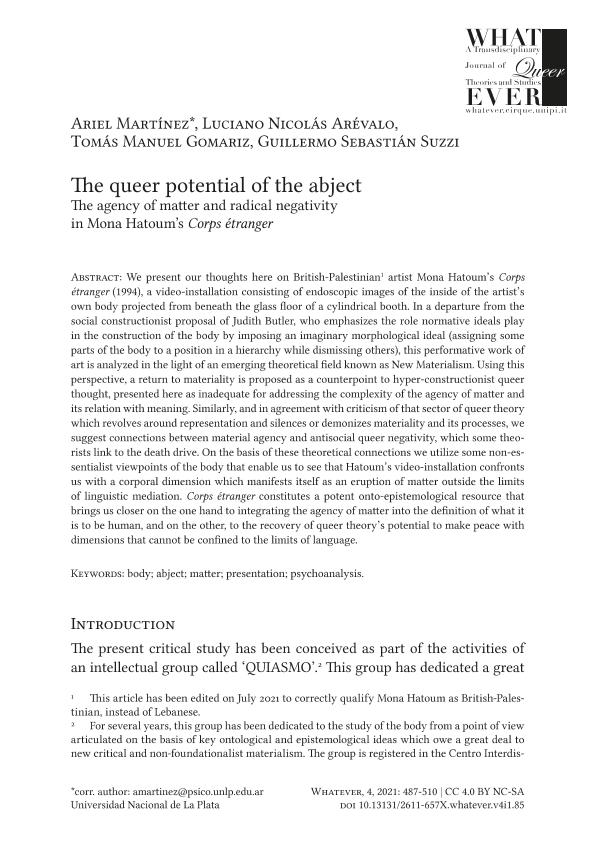Mostrar el registro sencillo del ítem
dc.contributor.author
Martínez, Ariel

dc.contributor.author
Arévalo, Luciano
dc.contributor.author
Gomariz, Tomás Manuel

dc.contributor.author
Suzzi, Guillermo Sebastián

dc.date.available
2022-12-15T14:10:10Z
dc.date.issued
2021-06
dc.identifier.citation
Martínez, Ariel; Arévalo, Luciano; Gomariz, Tomás Manuel; Suzzi, Guillermo Sebastián; The queer potential of the abject: The agency of matter and radical negativity in Mona Hatoum’s "Corps étranger"; Universitá di Pisa. Centro Interuniversitario di Ricerca Queer; Whatever; 4; 6-2021; 487-510
dc.identifier.issn
2611-657X
dc.identifier.uri
http://hdl.handle.net/11336/181319
dc.description.abstract
We present our thoughts here on British-Palestinian artist Mona Hatoum´s Corps étranger (1994), a video-installation consisting of endoscopic images of the inside of the artist´s own body projected from beneath the glass floor of a cylindrical booth. In a departure from the social constructionist proposal of Judith Butler, who emphasizes the role normative ideals play in the construction of the body by imposing an imaginary morphological ideal (assigning some parts of the body to a position in a hierarchy while dismissing others), this performative work of art is analyzed in the light of an emerging theoretical field known as New Materialism. Using this perspective, a return to materiality is proposed as a counterpoint to hyper-constructionist queer thought, presented here as inadequate for addressing the complexity of the agency of matter and its relation with meaning. Similarly, and in agreement with criticism of that sector of queer theory which revolves around representation and silences or demonizes materiality and its processes, we suggest connections between material agency and antisocial queer negativity, which some theorists link to the death drive. On the basis of these theoretical connections, we utilize some non-essentialist viewpoints of the body that enable us to see that Hatoum´s video-installation confronts us with a corporal dimension which manifests itself as an eruption of matter outside the limits of linguistic mediation. Corps étranger constitutes a potent onto-epistemological resource that brings us closer on the one hand to integrating the agency of matter into the definition of what it is to be human, and on the other, to the recovery of queer theory´s potential to make peace with dimensions that cannot be confined to the limits of language.
dc.format
application/pdf
dc.language.iso
eng
dc.publisher
Universitá di Pisa. Centro Interuniversitario di Ricerca Queer
dc.rights
info:eu-repo/semantics/openAccess
dc.rights.uri
https://creativecommons.org/licenses/by-nc/2.5/ar/
dc.subject
BODY
dc.subject
ABJECT
dc.subject
MATTER
dc.subject
PRESENTATION
dc.subject
PSYCHOANALYSIS
dc.subject.classification
Otras Psicología

dc.subject.classification
Psicología

dc.subject.classification
CIENCIAS SOCIALES

dc.title
The queer potential of the abject: The agency of matter and radical negativity in Mona Hatoum’s "Corps étranger"
dc.type
info:eu-repo/semantics/article
dc.type
info:ar-repo/semantics/artículo
dc.type
info:eu-repo/semantics/publishedVersion
dc.date.updated
2022-12-06T10:50:57Z
dc.journal.volume
4
dc.journal.pagination
487-510
dc.journal.pais
Italia

dc.journal.ciudad
Pisa
dc.description.fil
Fil: Martínez, Ariel. Consejo Nacional de Investigaciones Científicas y Técnicas. Centro Científico Tecnológico Conicet - La Plata. Instituto de Investigaciones en Humanidades y Ciencias Sociales. Universidad Nacional de La Plata. Facultad de Humanidades y Ciencias de la Educación. Instituto de Investigaciones en Humanidades y Ciencias Sociales; Argentina. Universidad Nacional de La Plata. Facultad de Humanidades y Ciencias de la Educación. Centro Interdisciplinario de Investigaciones de Género; Argentina
dc.description.fil
Fil: Arévalo, Luciano. Universidad Nacional de La Plata. Facultad de Humanidades y Ciencias de la Educación. Centro Interdisciplinario de Investigaciones de Género; Argentina
dc.description.fil
Fil: Gomariz, Tomás Manuel. Consejo Nacional de Investigaciones Científicas y Técnicas. Centro Científico Tecnológico Conicet - La Plata. Instituto de Investigaciones en Humanidades y Ciencias Sociales. Universidad Nacional de La Plata. Facultad de Humanidades y Ciencias de la Educación. Instituto de Investigaciones en Humanidades y Ciencias Sociales; Argentina. Universidad Nacional de La Plata. Facultad de Humanidades y Ciencias de la Educación. Centro Interdisciplinario de Investigaciones de Género; Argentina
dc.description.fil
Fil: Suzzi, Guillermo Sebastián. Consejo Nacional de Investigaciones Científicas y Técnicas. Centro Científico Tecnológico Conicet - La Plata. Instituto de Investigaciones en Humanidades y Ciencias Sociales. Universidad Nacional de La Plata. Facultad de Humanidades y Ciencias de la Educación. Instituto de Investigaciones en Humanidades y Ciencias Sociales; Argentina
dc.journal.title
Whatever
dc.relation.alternativeid
info:eu-repo/semantics/altIdentifier/url/https://whatever.cirque.unipi.it/index.php/journal/article/view/85
dc.relation.alternativeid
info:eu-repo/semantics/altIdentifier/doi/https://doi.org/10.13131/2611-657X.whatever.v4i1.85
Archivos asociados
